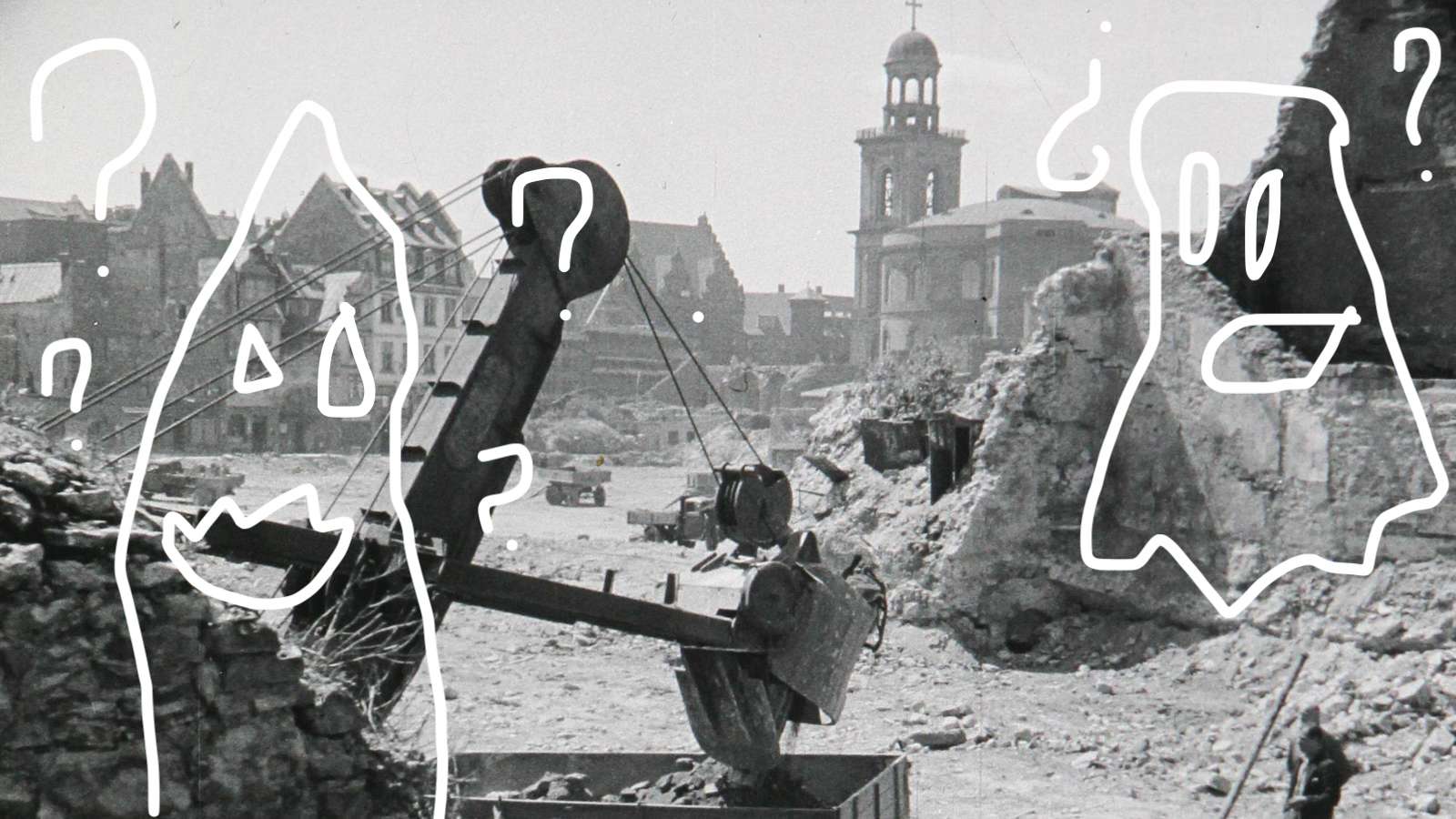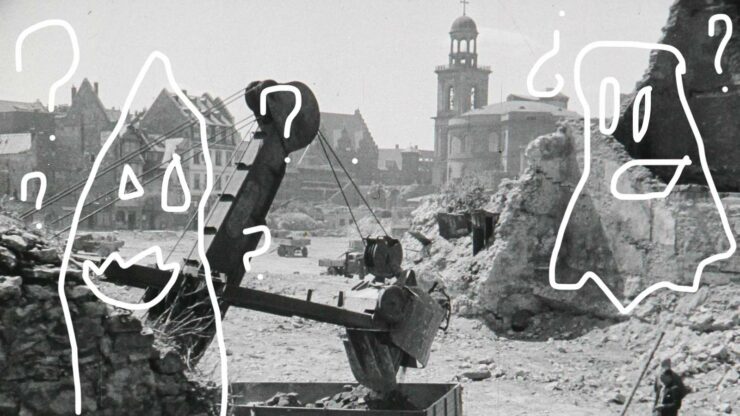[urban interfaces] Blogs
Guest blogpost: Verena Kämpken – Hauntological Architecture, Frankfurt’s newly built oldtown ensemble and spectral city politics. (Conversation between a Ghost and a Living)
For our [urban interfaces] seminar series on the theme The Magic City (2021-2022), we invited participants to write blogposts. The best and most interesting ones we publish on our website.
Below is the blogpost for seminar session #3, written by Verena Kämpken.
With a background of a BA in Sociology and Human Geography from Goethe-University in Frankfurt, Verena Kämpken currently studies the research master Arts, Media and Literary Studies at RUG. She gravitates towards questions of STS, New Media/Critical Data Studies, New Materialisms and their intersections.
Hauntological Architecture, Frankfurt’s newly built oldtown ensemble and spectral city politics.
(Conversation between a Ghost and a Living)
by Verena Kämpken
In 2018, in the middle of the city of Frankfurt am Main a whole newly built quarter celebrated its big opening after 10 years and 200 million euros were spent on its construction. Destructed in World War II, this 7000-square-meter-big chunk of bombed-away inner city areal now, roughly 80 years later, resembles its pre-war architecture. Where for some decades stood a peak-brutalist building from the early 70s, the voices advocating for reconstruction won the argument. The result is quite fascinating: a typically Hessian medieval-style town anno 2018 – the “new oldtown” or “Neue Altstadt”. Those buildings, whose original condition was better documented have been reconstructed with great accuracy, while the lesser-documented ones blend in as modernist abstractions of the traditional style of architecture (cf. Sturm/Schmal 2019). Its reception presents great diversity, from sceptics who despise it and accuse it to be “disneylandish”, to those pleasantly impressed. Seldomly, one has a neutral stance toward it. Inevitably, with this example of urban architecture many big questions resonate: How do we deal with history? Which parts of it do we honour with remembrance and which do we erase? How do we envision the future of this city? What is the city identity, and, who gets to define it? Who is this areal built for? Confronted with the myriad layers of city politics it is hard to pin down how to feel about the “new oldtown”. It certainly feels weird. But large-scale architectural projects in their state of piercing newness and striking totality always have a slightly eerie feeling to them. Yet, they have no memories, no traces of life. They risk being too designed and artificial, remaining somebody’s idea and several other bodies’ execution, instead of a setting for life.
Why does the new oldtown seem to have a special kind of weirdness to it? And how?
A paradoxical encounter of some person currently living in Frankfurt and a ghost from the city’s past might help define this felt uneasiness. Surprised by the possibility of their perception of each other, a conversation between the two sparked, that sheds light on the hauntological qualities of this architectural project:
Living: I have to say, out of all the places I could have met a ghost, it feels rather ironic that I meet one here, in this particularly haunted part of town.
Ghost: Oh yeah…? Why would you think it is specifically haunted? There are ghosts everywhere – not only here. The world is a crowded place!
Living: You’re probably right. I hadn’t initially thought about it in a literal sense though. Not haunted by dead people, but haunting in a post-Derridean-sense (cf. Gordon 2008). His concept of hauntology has become synonymous to theorizing the idea of history repeating itself, although there are many much more complex and rewarding elaborations on the dimensions of its meaning.
Ghost: Ah ok, history repeating itself… You do realize that quite literally is what happens here? Already in the 80s that row of traditional oldtown houses, the Römerberg-Ostzeile, just a few meters from the new oldtown was reconstructed (cf. Röger 2019). At the time, people were also highly sceptical of this approach, the press was full of opinions on it, whereas today this piece of city landscape has been widely accepted. It blends in so successfully that many people, especially the younger generation and those who migrated to Frankfurt after the 90s often don’t even have the knowledge of its reconstructedness. Your hauntological take should thus be: history literally repeats itself here with the discussions taking place amidst rebuilding.
Living: So I heard – and I wouldn’t have even noticed its artificiality if it hadn’t come up through the public discussions of this new area. Isn’t this also what is weird about it? German history, a bombing, and then you might never know that this isn’t the original one. I don’t even mean it from a perspective of authenticity, but rather regarding our respect towards what has happened. A reconstructive approach such as the new oldtown sits at the crossroads of remembrance and oblivion (cf. Termeer 2020). Usually, the patchwork of historical cities with missing pieces of oldtown tell a tale of previous incisions – one is left to wonder what has occurred: a fire, war, demolition? Within the German context, does a seamless filling of this violently removed hole mark some type of coming to terms?
Ghost: Those were the exact arguments in the 80s. With your repetition of these discussions around reconstruction, it feels like you and the other critics are those who do the haunting of the new oldtown. Are you the ghosts instead of me? I also wonder, what you would have liked to be built otherwise? Another area of empty luxury apartments for speculation or one more glassy mall? Other examples of Frankfurt’s city development in recent years, should have made clear that these would have been the alternatives.
Living: Don’t get me wrong, I certainly wouldn’t have preferred those lifeless modernities that you are referencing too either. But you know what, deep down, I believe, under the right circumstances, there would have been enough creative energy to imagine a timely, purpose-serving vision for the quarter, that could reference and not erase the chapters of history of this place. Don’t you think?
Ghost: They claimed exactly that for the technical town hall! Apparently, it’s ridiculous facade was a brutalist correspondence with the aesthetics of medieval timber framing (cf. Müller-Raemisch 1998: 345). For years that ugly brutalist building sat in the middle of my hometown insulting its past. I had a terrible time during that era of architecture. I felt very unhappy and quite disoriented for almost a century. Finally, I can feel comfortable and at home again. I love it here!
Living: It’s easy for you to love it though. At least you get to stay here. Have you heard how hard it is to find affordable housing in this city? By rebuilding a type of city from the Middle Ages have we build a whole quarter for ghosts instead of for those of us alive? Why is there no green, no space to breathe? Where are the ideas for inner-city living that keep cities alive and liveable for everyone? City politics shouldn’t prioritize the accommodation of their ghosts over its living inhabitants. A city centre built for ghosts…you are dead… that’s what’s weird!
This central urban area of Frankfurt embodies a multitude of visions across all temporalities: the original oldtown from before the destruction in the 1940s, the brutalist cubes of the in-between, the built reality of today, and of course, all possible alternatives, the lost futures, that could have been built here, had another vision based on a different set of values informed city development at the pivotal moment. Unfortunately, the past has demarcated the future that is now. Frankfurt’s new oldtown seems to be haunted in myriad ways. By the catastrophic history of German atrocities and its consequences, by loopy repetitions of critical discussions around pre-war reconstructions, and, what could be witnessed most impressively through the accidental séance between the Living and the Ghost, by those who used to inhabit the original oldtown. Eerily, the city’s ghosts seem to be more adequately accommodated in the new oldtown than the Frankfurters currently alive.
References
Gordon, Avery F. (2008): Ghostly matters: Haunting and the sociological imagination. Minneapolis/London: University of Minnesota Press.
Müller-Raemisch, Hans Reiner (1998): Frankfurt am Main. Stadtentwicklung und Planungsgeschichte seit 1945. Frankfurt: Campus.
Röger, Moritz (2019): (Re-)Construction of History – The Debate about the Römerberg-Ostzeile. In: Sturm, Philipp/Schmal, Peter Cachola (eds.): Forever New: Frankfurt’s Old Town: Building between Dom and Römer since 1900. Bilingual Edition. Berlin: Jovis: 281-283.
Sturm, Philipp/Schmal, Peter Cachola (eds.): Forever New: Frankfurt’s Old Town: Building between Dom and Römer since 1900. Bilingual Edition. Berlin: Jovis.
Termeer, Marcus (2020): Dialektik des Erinnerns und Vergessens, oder: Neugebaute Altstadtensembles als Deckerinnerungen angesichts einer katastrophalen Geschichte. In: Heinlein, Michael/Dimbath, Oliver (eds.): Katastrophen zwischen sozialem Erinnern und Vergessen. Zur Theorie und Empirie sozialer Katastrophengedächtnisse. Wiesbaden: Springer: 279-302.


